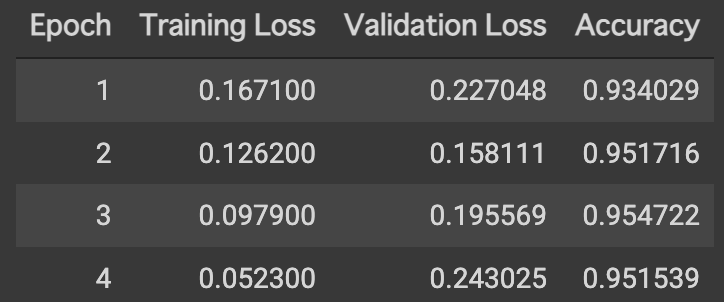JGLUE/MARC-jaをGoogle Colabで評価してみる
TL;DR
ヤフー株式会社により、標準的な自然言語処理の標準ベンチマークであるGLUEの日本語版としてJGLUEが公開されています。
今回は日本語の二項分類タスクの評価用データセットであるMARC-jaについて、Google Colab上で実際に評価してみました。モデルはHuggingfaceを利用し、以下に対するファインチューニングを行っています。
| No. | Model | Train example num | Valid(Dev) example num | Accuracy | Time | Note |
|---|---|---|---|---|---|---|
| 1 | JGLUE - Tohoku BERT base(※) | 187,528 | 5,654 | 0.958 | na | JGLUE公式 |
| 2 | 今回 - Tohoku BERT base(※) | 187,528 | 5,654 | 0.955 | 約6時間50分 | TPU利用、4 Epochs中最高の結果 |
| 3 | 今回 - Tohoku BERT base(※) | 15,000 | 2,500 | 0.942 | 約1時間40分 | GPU利用、4 Epochs中最高の結果 |
| 4 | 今回 - Tohoku BERT base(※) | 15,000 | 2,500 | 0.948 | 約40分 | TPU利用、4 Epochs中最高の結果 |
※ JGLUE公式に合わせてTohoku BERT baseと表記していますが、cl-tohoku/bert-base-japanese-v2と同一です(-v2である点に注意)。
なお、JGLUEで公開されているベンチマークとハイパーパラメータをできる限り合わせていますが、評価用のスクリプト(run_glue.py)を使用していなかったり、バッチサイズが異なる等、厳密には一致しない点にご注意ください。
MARC-ja
Multilingual Amazon Reviews Corpus (MARC)から日本語のレビューを抜粋したものです。星評価による判断の他にクラウドソーシングによる評価を交えてpositive、negativeの2クラスにラベルされています。
| No. | Dataset | Positive num | Negative num | (Negative) Ratio |
|---|---|---|---|---|
| 1 | Train | 165,477 | 22,051 | 0.133 |
| 2 | Valid(Dev) | 4,832 | 822 | 0.170 |
データの準備
MARC-jaはJGLUEのGithubに格納されていないため、個別にダウンロードしてスクリプトで処理する必要があります。データ準備の手順については以下を参照してください。
処理した結果、以下のファイルが生成されます。以降の手順はこれらのファイルをGoogle Drive上にアップロードしてある前提としています。
- train-v1.0.json
- valid-v1.0.json
モジュールの準備
!pip install ipadic
!pip install datasets
!pip install transformers
!pip install sklearn
!pip install fugashi
!pip install unidic-lite
!pip install accelerate # for auto_find_batch_size
データ変換
準備したMARC-jaのデータをGoogle Driveにアップロードしてある前提です。Google Driveをマウントしてデータセットを読み込んでいます。
from google.colab import drive
drive.mount('/content/drive')
from datasets import load_dataset
dataset = load_dataset('json', data_files={
'train': '/content/drive/MyDrive/[Your Dataset Parent Path]/marc_ja-v1.0/train-v1.0.json',
'valid': '/content/drive/MyDrive/[Your Dataset Parent Path]/marc_ja-v1.0/valid-v1.0.json',
}).map(lambda example: {'label': 1 if example['label'] == 'positive' else 0})
display(dataset)
[Your Dataset Parent Path]を実際のパスで置き換えてください。
from transformers import AutoTokenizer
tokenizer = AutoTokenizer.from_pretrained('cl-tohoku/bert-base-japanese-v2')
def tokenize_function(examples):
return tokenizer(examples['sentence'], padding='max_length', truncation=True, max_length=512)
tokenized_datasets = dataset.map(tokenize_function, batched=True)
small_train_ds = tokenized_datasets['train'].shuffle(seed=51).select(range(15000))
small_valid_ds = tokenized_datasets['valid'].shuffle(seed=51).select(range(2500))
seed=51でサンプリングしています。
モデルの準備
from transformers import AutoModelForSequenceClassification
model = AutoModelForSequenceClassification.from_pretrained('cl-tohoku/bert-base-japanese-v2', num_labels=2)
トレーニングの実行
import numpy as np
from datasets import load_metric
metric = load_metric('accuracy')
def compute_metrics(eval_pred):
logits, labels = eval_pred
predictions = np.argmax(logits, axis=-1)
return metric.compute(predictions=predictions, references=labels)
from transformers import TrainingArguments, Trainer
training_args = TrainingArguments(output_dir='outputs',
evaluation_strategy='epoch',
auto_find_batch_size=True,
learning_rate=5e-05,
num_train_epochs=4,
warmup_ratio=0.1,
save_steps=5000
)
trainer = Trainer(
model=model,
args=training_args,
#train_dataset=tokenized_datasets['train'],
train_dataset=small_train_ds,
#eval_dataset=tokenized_datasets['valid'],
eval_dataset=small_valid_ds,
compute_metrics=compute_metrics,
)
%%time
trainer.train()
結果の保存
outputs = trainer.predict(small_valid_ds)
import pandas as pd
preds_df = pd.DataFrame({
'pred': outputs.predictions.argmax(axis=-1),
'label': outputs.label_ids
})
preds_df.to_csv('/content/drive/MyDrive/[Your Dataset Parent Path]/bert-gpu-result.csv')
TPUを利用したフルデータセットの評価
MARC-jaの全てのレコードを利用すると、(引き当てるGPUにもよりますが)Google ColabのGPUインスタンスでも12時間以上かかるため、無料版だと実行できない可能性があります。このため、前述の例ではサンプリングした上でベンチマークしていますが、TPUインスタンスを利用して全レコードによる評価を行うことも可能です。
モジュールの準備
!pip install ipadic
!pip install datasets
!pip install transformers
!pip install sklearn
!pip install fugashi
!pip install unidic-lite
!pip install accelerate # for auto_find_batch_size
!pip install cloud-tpu-client==0.10 https://storage.googleapis.com/tpu-pytorch/wheels/torch_xla-1.8-cp37-cp37m-linux_x86_64.whl # for TPU
!pip install torch==1.8 torchtext==0.9.0 # for TPU
cl-tohoku/bert-base-japanese-v2はPyTorchによるモデルとなっています。TPUでの実行最適化にcloud-tpu-clientを利用していますが、PyTorch-1.8にしか対応していないため、PyTorchを1.8にダウングレードしています(最新のTransformersだと1.9がインストースされるため)。
データ変換
from google.colab import drive
drive.mount('/content/drive')
from datasets import load_dataset
dataset = load_dataset('json', data_files={
'train': '/content/drive/MyDrive/[Your Dataset Parent Path]/marc_ja-v1.0/train-v1.0.json',
'valid': '/content/drive/MyDrive/[Your Dataset Parent Path]/marc_ja-v1.0/valid-v1.0.json',
}).map(lambda example: {'label': 1 if example['label'] == 'positive' else 0})
display(dataset)
[Your Dataset Parent Path]を実際のパスで置き換えてください。
from transformers import AutoTokenizer
tokenizer = AutoTokenizer.from_pretrained('cl-tohoku/bert-base-japanese-v2')
def tokenize_function(examples):
return tokenizer(examples['sentence'], padding='max_length', truncation=True, max_length=512)
tokenized_datasets = dataset.map(tokenize_function, batched=True)
モデルの準備
from transformers import AutoModelForSequenceClassification
model = AutoModelForSequenceClassification.from_pretrained('cl-tohoku/bert-base-japanese-v2', num_labels=2)
トレーニングの実行
import numpy as np
from datasets import load_metric
metric = load_metric('accuracy')
def compute_metrics(eval_pred):
logits, labels = eval_pred
predictions = np.argmax(logits, axis=-1)
return metric.compute(predictions=predictions, references=labels)
from transformers import TrainingArguments, Trainer
training_args = TrainingArguments(output_dir='outputs',
evaluation_strategy='epoch',
#auto_find_batch_size=True,
per_device_train_batch_size=16,
learning_rate=5e-05,
num_train_epochs=4,
warmup_ratio=0.1,
save_steps=5000,
tpu_num_cores=8
)
trainer = Trainer(
model=model,
args=training_args,
train_dataset=tokenized_datasets['train'],
eval_dataset=tokenized_datasets['valid'],
compute_metrics=compute_metrics,
)
%%time
trainer.train()
結果の保存
outputs = trainer.predict(tokenized_datasets['valid'])
import pandas as pd
preds_df = pd.DataFrame({
'pred': outputs.predictions.argmax(axis=-1),
'label': outputs.label_ids
})
preds_df.to_csv('/content/drive/MyDrive/[Your Dataset Parent Path]/bert-tpu-full-result.csv')

